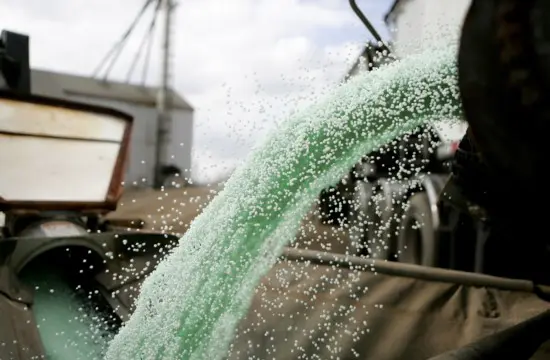Too much dessert is not good for your waistline. And too much fertilizer can have a detrimental effect on your crops, your soil and the environment. Farmers today must pay even closer attention to enhancing the uptake, utilization and efficiency of nitrogen (N) and phosphorus (P) with available products and technologies to limit nutrient loss, and, ultimately, improve yields.
In 2011, Daniel E. Kaiser and John A. Lamb, who are extension soil specialists at the University of Minnesota Soil Testing Lab, along with Director Roger Eliason, noted, “Total fertilizer management, which optimizes nutrient efficiency, will be needed to increase future production and profitability.”
What’s more, farmers face increasing pressure from legislative, regulatory and non-government organizations to limit fertilizer use. By following The Fertilizer Institute’s 4R Nutrient Stewardship program and best management practices (BMPs), farmers are encouraged to select the right product, apply the right amount at the right time and in the right place to match plant needs and reduce nutrient losses.
Know What You Need
So how do farmers best address efficient nutrient management? Fabian Fernandez, University of Minnesota Extension soil specialist, says in the case of phosphorus, it begins with soil testing to determine what is present before making decisions on how much, where and when to apply.
“While there are typically large amounts of phosphorus present in soils, it is quickly converted to insoluble compounds,” says Fernandez. “As a result, utilization of the fertilizer phosphorus by plants is usually less than 30 percent the first year after application… Low recovery is the result of low phosphorus concentrations in the soil solution.”
Plus, plant root exploration is limited. Phosphorus not recovered may be taken up by crops in future years, note Kansas State Extension specialists in the “Phosphorus Facts” Bulletin, January 2011.
“If P test levels are low, an application will produce the greatest return on investment. The likelihood of a yield increase due to the fertilizer is greatest,” says Fernandez. “If soil test levels are adequate, farmers can make informed decisions about what to do based on the situation. If farmers decide to apply less, they could, for example, apply only P in a starter. Or, choose not to apply at all because the potential to increase yield might not be as great. There is sufficient P there to get by for the time being.”
Applying P in high or very high P level soils will not bump yield and may create water quality issues, Fernandez adds. He advises farmers to follow state guidelines for application rates.
When it comes to nitrogen applications and utilization of N by plants, Fernandez says to begin by using the N rate calculator found at http://cnrc.agron.iastate.edu/. The calculator helps farmers determine where the optimum yield may exist, based on agronomics and economics.
“There are a lot of factors that are difficult to predict, but more often than not, farmers will be in the most profitable range by following the N rate provided with the calculator,” says Fernandez.
Farmers also must remember to give proper credit to the previous crop, including alfalfa or other legumes, which can reduce the amount of N needed for the following corn crop. There is no need to adjust for soybeans since it is one of the options already in the calculator.
“Besides applying the correct amount, it is important to minimize the amount of potential N loss,” says Fernandez. “Any N applied and lost to the environment is gone. The crop will not be able to use it. The best thing to do is try to apply N closer to the time when the crop will use it.”
Stabilizers and Enhancers for Productive Applications
In addition to timing applications when the crops utilize N and P, farmers can incorporate use of N stabilizers or P enhancers to help maintain nutrient availability in the soil and limit nutrient loss or fixation.
University of Arkansas Extension recommends in its “Nitrogen Fertilizer Additives” Bulletin, “In most cases, these products temporarily inhibit or delay, but do not permanently prevent a specific process of the nitrogen cycle… The expected benefits of additives occur when conditions exist for significant N loss in conventional fertilizers via ammonia volatilization and/or leaching, runoff and denitrification of nitrate.”
Nutrient sources still must be appropriate for the time and method of application, advises Fernandez. For example, applying urea on the soil surface stands to lose N to volatilization. In that situation, using a urease inhibitor would be important, he says. On the other hand, with broadcasting urea and incorporating it immediately with tillage or irrigation, there is no need.
Research has found that soluble polymer technology, whether used for phosphorus or nitrogen fertilizers, can reduce fixation of applied nutrients and keep more of the nutrients available for plants – contributing to higher yields and reducing nutrient losses.

